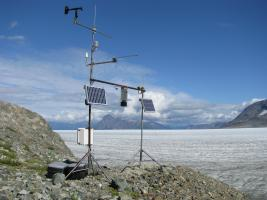


気候変動は、社会のさまざまな側面に課題をもたらす重要な世界的問題であり、そのため、これらの問題を調査するグループは多面的でなければなりません。ユーコン大学ユーコン研究センター (YRC) が運営する気候変動研究チームは、変化する世界に適応するための教育とソリューションを提供する研究を実施および推進しています。
気候変動研究のウェブサイトをご覧ください。
水力発電はユーコン準州の主なエネルギー源であり、ユーコン準州、マヨ川、アイシヒク川の水文学を研究し、潜在的な発電量を予測する能力は、エネルギー資源の計画強化を可能にします。水力発電が利用できない場合の代替手段は化石燃料の燃焼ですが、これは比較的高価で炭素を大量に排出します。水力発電の計画と管理を支援するために、YRC はユーコン エネルギー コーポレーションと提携しました。この提携により、ブリティッシュ コロンビア州北部、ユーコン準州南部および中央部の主要な河川流域における基礎調査の完了、モデリングおよび予測ツールの開発、遠隔気象観測所の設置が支援されました。
既存のネットワークにおける重要なデータ ギャップは、積雪水量 (SWE) です。春に積雪から放出される水、つまり「春の降水」がダムの主な水源だからです。Campbell Scientific CS725 積雪水量センサーは、非接触方式で SWE を測定するため、この用途に最適です。このセンサーは、地面から自然に発生する電磁エネルギーの減衰を検出することで SWE を測定します。エネルギーの減衰は、軽い粉雪、密な氷、またはその中間の雪など、あらゆる形態の水によってのみ発生します。
これまで、SWE を遠隔測定する標準は「スノー ピロー」で、これは不凍液の袋に積もった降水量の重さを測定するものでした。スノー ピローには、降水量の蓄積、放射特性、その他の要因が変化するという欠点があり、これが測定対象の積雪に影響を及ぼします。積雪に影響すると、測定精度が低下する可能性があります。CS725 は非接触式であるため、こうした欠点はありません。
ユーコン カレッジ (現在はユーコン大学) は、CS725 とともに、Campbell Scientificの気象計測機器一式を 4 つの遠隔地に設置しました。これらの場所は、タク川トリンギット族、シャンパンおよびアイシヒク先住民族、ナチョ ニャック ダン先住民族の伝統的領土にあり、道路でアクセスするのは困難または不可能で、携帯電話ネットワークもまったく通じません。Campbell Scientificは、過酷な遠隔地環境に適した総合的な気象監視ソリューション、さまざまな通信オプション、およびデータ管理サービスを提供しています。
データの収集、ホスティング、配信は、Campbell Scientific のデータ サービスによって提供されます。データは Iridium 衛星接続によって送信され、Campbell Scientific の施設で保存および監視されます。そこでデータは品質保証と品質管理 (QA/QC) を受け、安全な Web アクセスを介してクライアントに提供されます。
Campbell Scientificの堅牢な環境計測機器を使用することで、このプロジェクトは今後何年にもわたって学術界やエネルギー政策に貴重なデータを提供することが期待されます。
ケーススタディの概要
アプリケーション
水文学研究のための気象パラメータと積雪水量の遠隔監視場所
カナダ、ユーコン準州およびブリティッシュコロンビア州北部使用製品
CS725寄稿者
Eric Courtin (Campbell Scientific Canada), Lacia Kinnear (Climate Change Research), Jeffrey Kavanaugh (University of Alberta)参加団体
ユーコン大学、ユーコンエネルギー、ユーコン地質調査所、アルバータ大学計測項目
積雪水量、降雨量、積雪深、気圧、気温と相対湿度、土壌温度、風速と風向、正味放射PDFで見る